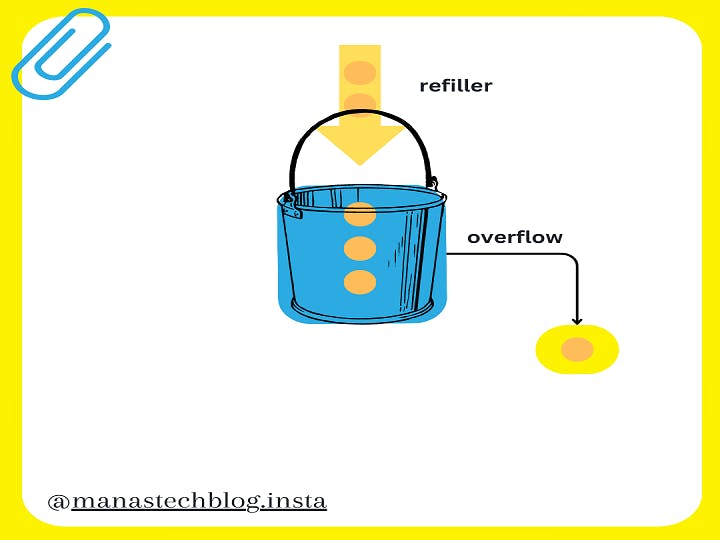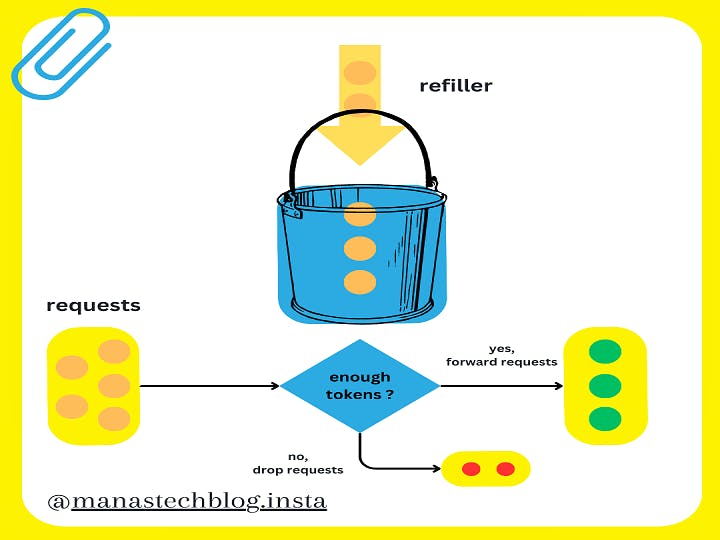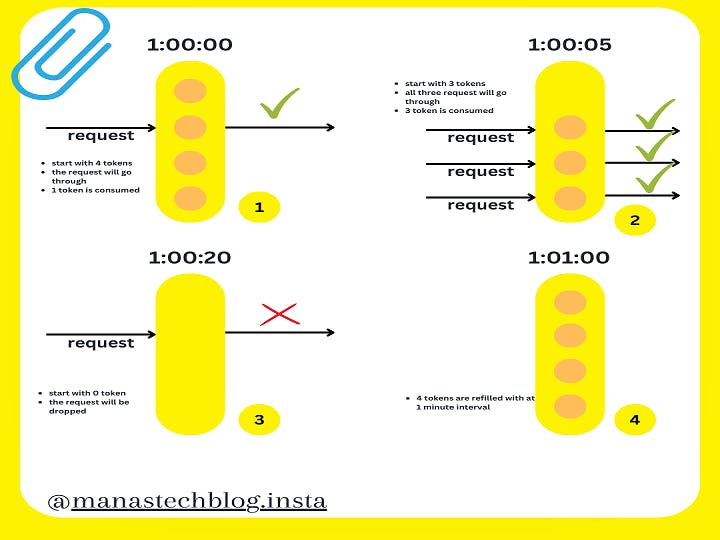Table of contents
A rate limiter is a common component in system design that helps control the rate at which certain operations or requests are allowed to occur. It acts as a mechanism to prevent overloading a system by limiting the number of requests or actions processed within a specified time period.
A rate limiter is employed to regulate the flow of traffic originating from a client or service. Within the realm of HTTP, this mechanism restricts the number of client requests permitted within a designated timeframe. If the count of API requests surpasses the threshold set by the rate limiter, any surplus calls are obstructed.
Algorithms For Rate Limiting
Rate limiting is a crucial technique used in system design to control the rate at which certain operations or requests are allowed to be processed. It helps protect systems from abuse, prevents resource exhaustion, and ensures fair usage among users.
Token Bucket Algorithm
The token bucket algorithm is a rate limiting technique that controls the rate at which requests or operations are allowed to occur. It uses the concept of tokens in a bucket to regulate the flow of requests.
In this algorithm, requests are regulated using tokens in a token bucket.
Tokens are added to the bucket at a fixed rate, and each request consumes a specific number of tokens.
If the bucket has enough tokens to accommodate a request, it is processed, and tokens are deducted accordingly.
If the bucket is empty, either the request is rejected or delayed until enough tokens are available.
Here's a detailed explanation of how the token bucket algorithm works:
Initialization:
Define the maximum number of tokens the bucket can hold (bucket size) and the rate at which tokens are added to the bucket (token generation rate).
Initialize the bucket with a certain number of tokens, which could be equal to the bucket size or a lower initial value.
Token Generation:
At regular intervals, tokens are added to the bucket according to the token generation rate.
For example, if the token generation rate is 10 tokens per second, one token will be added every 0.1 seconds.
Request Processing:
When a request arrives, the system checks if there are enough tokens in the bucket to accommodate the request.
Each request consumes a specific number of tokens, representing the cost or weight of the request.
If the bucket has sufficient tokens, the request is processed, and the corresponding number of tokens is deducted from the bucket.
If the bucket does not have enough tokens, the request is either rejected or handled separately, depending on the system's configuration.
Token Expiration:
Tokens in the bucket have an expiration time associated with them.
If tokens remain unused for a certain period, they may expire and be removed from the bucket.
This helps to prevent the accumulation of a large number of unused tokens, ensuring that the rate limiting mechanism stays relevant.
The token bucket algorithm takes two parameters:
Bucket size: It is the maximum number of tokens that can be allowed in the bucket.
Refill Rate: It is the number of tokens that can be put into the bucket every second.
The token bucket algorithm provides a flexible approach to rate limiting. Bursty traffic can be handled efficiently because the tokens accumulate in the bucket during idle periods, allowing short bursts of requests to be processed quickly as long as there are enough tokens available. If the bucket becomes empty, subsequent requests will need to wait until new tokens are generated and added to the bucket.
The token bucket algorithm can be customized based on system requirements. For example, the token generation rate can be adjusted dynamically to handle varying traffic patterns or to enforce different rate limits for different types of requests. Additionally, the token cost associated with each request can be set based on the desired prioritization or resource allocation within the system.
Overall, the token bucket algorithm is a popular choice for rate limiting due to its simplicity, effectiveness in handling bursts, and its ability to provide predictable and controlled request processing rates.
Advantages:
Smooth Traffic Control: The Token Bucket Algorithm provides a smooth and controlled flow of requests by regulating the rate at which tokens are consumed. It helps prevent sudden spikes or overwhelming bursts of traffic, ensuring stability and predictability in system performance.
Flexibility: This algorithm allows for flexibility in defining the rate limits and token generation rate, making it adaptable to different traffic patterns and varying system requirements. It can handle both low and high-intensity workloads effectively.
Fairness and Resource Allocation: By assigning a cost or weight to each request, the Token Bucket Algorithm enables fair resource allocation among users. It ensures that each user receives a fair share of available resources, preventing any particular user from monopolizing system resources.
Simple Implementation: The algorithm is relatively simple to implement and understand, making it accessible to developers. It doesn't require complex calculations or intricate logic, making it easier to integrate into systems.
Disadvantages:
Delayed Response for Excessive Requests: If the number of requests exceeds the number of available tokens in the bucket, the algorithm may delay processing or reject the excess requests. This can result in delayed responses or even rejection of legitimate requests during high traffic periods.
Token Accumulation: During periods of low traffic or idle moments, tokens may accumulate in the bucket. This can lead to a burst of requests being processed when traffic suddenly increases, potentially causing temporary resource overload.
Resource Wastage: In some cases, tokens may expire if they remain unused for a certain period. This can result in wasted resources if tokens are not utilized effectively. Proper configuration of token expiration time is necessary to optimize resource usage.
Difficulty in Handling Spiky Traffic: While the Token Bucket Algorithm can handle bursty traffic to some extent, it may struggle to efficiently handle extremely sudden and large traffic spikes. Adjustments or additional mechanisms may be required to manage such scenarios effectively.
When considering the Token Bucket Algorithm, it's important to assess its trade-offs based on the specific requirements and characteristics of the system. Factors such as expected traffic patterns, desired fairness, response time requirements, and resource availability should be considered to determine whether the algorithm is suitable for a particular system design.
Summarizing Up
In summary, rate limiters offer a range of benefits including preventing overload, protecting against attacks, ensuring fair resource allocation, improving scalability, enhancing stability and availability, safeguarding third-party integrations, and enabling usage-based billing. These benefits contribute to the overall reliability, performance, and security of a system.
The Token Bucket Algorithm is a rate limiting technique that controls the flow of requests. It uses tokens in a bucket, generated at a fixed rate, to regulate the processing of requests. When a request arrives, it consumes a certain number of tokens. If there are enough tokens in the bucket, the request is processed, and tokens are deducted. If tokens are insufficient, the request is either rejected or handled separately. The algorithm ensures a smooth traffic flow, allows bursty traffic handling, promotes fairness, and provides flexibility in defining rate limits. It is relatively simple to implement but may experience delayed responses during high traffic or waste resources if tokens expire unused.



